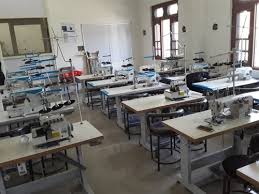Free Sewing Machine Operator Course(1year Diploma)
Sewing Machine Operator click here
Brief Job Description:- A Sewing Machine Operator, also called a ‘Stitcher or Machinist’ is an important job-role associated with Apparel sector. The primary responsibility of a machinist is to stitch/ sew fabric, fur, or synthetic materials to produce apparels Sewing Machine Operator Course.
Personal Attributes:-A Sewing Machine Operator should have good eyesight, eyehand-leg coordination, motor skills and vision (including near vision, distance vision, colour vision, peripheral vision, depth perception and ability to change focus).

Prepare for stitching operations Sewing Machine Operator Course:- To be competent, the user/individual on the job must be able to:

PC1. Make sure the work area is free from hazards
PC2. Follow the instructions on the work ticket/ job card in line with the responsibilities of respective job role
PC3. Ask questions to obtain more information on tasks when the instructions you have are unclear
PC4. Agree and review your agreed upon work targets with your supervisor and check for special instructions, if any
PC5. Use the correct tools and equipments
PC6. Check that equipment is safe and set up in readiness for use
PC7. Select the correct component parts for the style being worked on
PC8. Check that the materials to be used are free from faults Sewing Machine Operator Course.
PC9. Ensure the materials used meet the specification matching a. Within a product b. Between a pair of products where applicable
PC10. Carry out test sews
PC11. Check needles, awls and threads regularly
PC12. Check if fabric / Component is correctly marked and pieces cut as required
PC13. Fabric pieces and linings are pinned or sewn together as required, and appropriately hung in readiness for assembly.
PC14. Report faults in the materials
PC15. Conform to company quality standards
PC16. Report any damaged work to the responsible person
PC17. Follow company reporting procedures about defective tools and machines which affect work and report risks/ problems likely to affect services to the relevant person promptly and accurately
PC18. Sort and place work to assist the next stage of production and minimise the risk of damage
PC19. Leave work area safe and secure when work is complete
PC20. Complete forms, records and other documentation Sewing Machine Operator Course.


Stitch components to produce apparels Sewing Machine Operator Course:- To be competent, the user/individual on the job must be able to:

PC21. Make sure the work area is free from hazards
PC22. Carry out work functions in line with the responsibilities of your job role
PC23. Examine the specific item to identify what type of stitching is best suited
PC24. Ask questions to obtain more information on tasks when the instructions are unclear and finalize the stitching option with the supervisor, in case of queries
PC25. Estimate the expected length of time for the process
PC26. Set up machine ((Apparel Sewing machine) according to manufacturers’ instructions and production requirements
PC27. Use the correct machine, tools (eg: Scissors, Measuring tapes and rulers) and equipment
PC28. Set machine controls for the materials being stitched
PC29. Cut the thread appropriately
PC30. Thread the needle in the machine and adjust the needle as per the requirements
PC31. Perform a test run to ensure machine is operating correctly
PC32. Report defective machines, tools and/or equipment to the responsible person
PC33. Operate machines safely and in accordance with guidelines Sewing Machine Operator Course.
PC34. Optimize the positioning and layout of materials to ensure a smooth and rapid throughput
PC35. Check the equipment prior to making the stitching, including:
PC36. Correct controls
PC37. Correct attachments
PC38. Changing needles
PC39. Changing threads
PC40. Changing awls
PC41. Correct Timing
PC42. Stitch the correct materials in the right sequence as required by the production specification PC43. Ensure stitched product conforms to shape and size requirement
PC44. Ensure stitched products meets specification in terms of labels and trimmings
PC45. Inspect stitched products against specifications
PC46. Identify mark and place rejects in the designated locations
PC47. Carry out alterations to meet customer requirements Sewing Machine Operator Course.
PC48. Pass the stitched item to the next stage in the manufacturing process after validation
PC49. Respond accordingly where stitched items do not meet production specification
PC50. Minimise and dispose the waste materials in the approved manner
PC51. Seek feedback from team mates on work related performance
PC52. Check with in charge /others when unsure of new product details
PC53. Clean and make safe machines after use
PC54. Carry out basic maintenance of own machines
PC55. Report risks/ problems likely to affect services to the relevant person promptly and accurately
PC56. Complete forms, records and other documentation
PC57. Sew and apply trims by hand and machine
PC58. Carry out Operations at a rate which maintains workflow and meets production targets Sewing Machine Operator Course.


Contribute to achieving the product quality in stitching operations Sewing Machine Operator Course:-

To be competent, the user/individual on the job must be able to:
PC1. Identify and use materials required based on the job card/ work ticket
PC2. Take the necessary action when materials do not conform to company quality standards
PC3. Report and replace identified faulty materials and component parts which do not meet specification
PC4. Identify modifiable defects and rework on them
PC5. Carry out work safely and at a rate which maintains work flow
PC6. Report to the responsible person when the work flow of other production areas disrupts work
PC7. Test, sort, track feed and examine work in progress Sewing Machine Operator Course.
PC8. Carry out quality checks at specified intervals according to instructions
PC9. Apply the allowed tolerances
PC10. Identify faults and take appropriate action for rectification
PC11. Make adjustments promptly to return product to specification
PC12. Fault-find materials and components for creased, stained, damage and incorrectly made-up component parts
PC13. Report faults in other processes to the appropriate person
PC14. Maintain the required productivity and quality levels
PC15. Complete and maintain documentation


Maintain the work area, tools and machines Sewing Machine Operator Course:- To be competent, the user/individual on the job must be able to:

PC1. Handle materials, machinery, equipment and tools safely and correctly
PC2. Use correct lifting and handling procedures
PC3. Use materials to minimize waste
PC4. Maintain a clean and hazard free working area
PC5. Maintain tools and equipment
PC6. Carry out running maintenance within agreed schedules
PC7. Carry out maintenance and/or cleaning within one’s responsibility
PC8. Report unsafe equipment and other dangerous occurrences
PC9. Ensure that the correct machine guards are in place
PC10. Work in a comfortable position with the correct posture Sewing Machine Operator Course.
PC11. Use cleaning equipment and methods appropriate for the work to be carried out
PC12. Dispose of waste safely in the designated location
PC13. Store cleaning equipment safely after use
PC14. Carry out cleaning according to schedules and limits of responsibility
Comply with health, safety and security requirements at work Sewing Machine Operator Course:- To be competent, the user/individual on the job must be able to:
PC1. Comply with health and safety related instructions applicable to the workplace
PC2. Use and maintain personal protective equipment as per protocol
PC3. Carry out own activities in line with approved guidelines and procedures
PC4. Maintain a healthy lifestyle and guard against dependency on intoxicants
PC5. Follow environment management system related procedures
PC6. Identify and correct (if possible) malfunctions in machinery and equipment
PC7. Report any service malfunctions that cannot be rectified
PC8. Store materials and equipment in line with manufacturer’s and organisational requirements
PC9. Safely handle and move waste and debris Sewing Machine Operator Course.
PC10. Minimize health and safety risks to self and others due to own actions
PC11. Seek clarifications, from supervisors or other authorized personnel in case of perceived risks PC12. Monitor the workplace and work processes for potential risks and threats
PC13. Carry out periodic walk-through to keep work area free from hazards and obstructions, if assigned
PC14. Report hazards and potential risks/ threats to supervisors or other authorized personnel
PC15. Participate in mock drills/ evacuation procedures organized at the workplace
PC16. Undertake first aid, fire-fighting and emergency response training, if asked to do so
PC17. Take action based on instructions in the event of fire, emergencies or accidents
PC18. Follow organisation procedures for shutdown and evacuation when required
Comply with legal and ethical requirements:- To be competent, the user/individual on the job must be able to:
PC1. Carry out work functions in accordance with legislation and regulations, organizational guidelines and procedures
PC2. Seek and obtain clarifications on policies and procedures, from your supervisor or other authorized personnel
PC3. Apply and follow these policies and procedures within your work practices
PC4. Provide support to your supervisor and team members in enforcing these considerations
PC5. Identify and report any possible deviation to these requirements Sewing Machine Operator Course.
Organisational Context:- The user/individual on the job needs to know and understand:
KA1. Personal hygiene and duty of care
KA2. Safe working practices and organisational procedures
KA3. Limits of your own responsibility
KA4. Ways of resolving with problems within the work area
KA5. The production process and the specific work activities that relate to the whole process
KA6. The importance of effective communication with colleagues
KA7. The lines of communication, authority and reporting procedures
KA8. The organisation’s rules, codes and guidelines (including timekeeping)
KA9. The company’s quality standards
KA10. The importance of complying with written instructions
KA11. Equipment operating procedures / manufacturer’s instructions
Technical / Domain Knowledge:- The user/individual on the job needs to know and understand:
KB1. Work instructions and specifications and interpret them accurately
KB2. Method to make use of the information detailed in specifications and instructions
KB3. Relation between work role and the overall manufacturing process
KB4. The importance of taking action when problems are identified
KB5. Different ways of minimising waste
KB6. The importance of running maintenance and regular cleaning
KB7. Effects of contamination on products i.e. Machine oil, dirt
KB8. Common faults with equipment and the method to rectify
KB9. Maintenance procedures
KB10. Hazards likely to be encountered when conducting routine maintenance
KB11. Different types of cleaning equipment and substances and their use
KB12. Safe working practices for cleaning and the method of carrying them out
Core Skills / Generic Skills:- The user/ individual on the job needs to know and understand how to:
SA1. Respond to emergencies, accidents or fire at the workplace
SA2. Evacuate the premises and help others in need while doing so
SA3. The value of physical fitness, personal hygiene and good habits
Professional Skills:- The user/ individual on the job needs to know and understand how to:
SB1. Raise alarm
SB2. Safe and correct procedure of handling equipment and machinery
SB3. Identify, report malfunctions in machinery and equipment and correct them if possible
SB4. Identify and report service malfunctions and chemical leaks
SB5. Keep work area free from potential hazards
SB6. Report to supervisors and other authorized personnel for assistance








